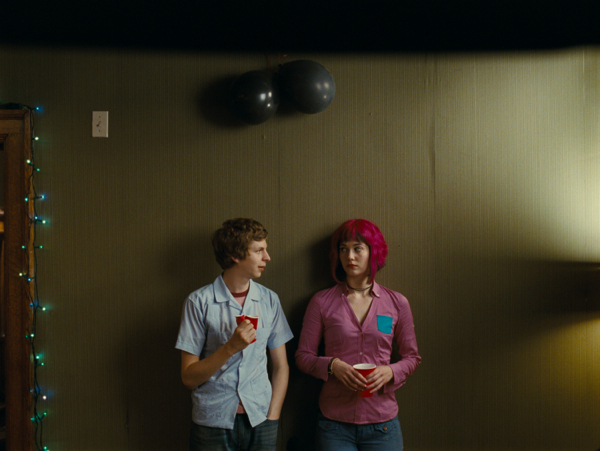Movie review by Greg Carlson
Edgar Wright capitalizes on his cult status as an expert craftsman of clever, pop culture-referencing entertainment with “Scott Pilgrim vs. the World,” a bubblegum fantasy of young adulthood adapted from Bryan Lee O’Malley’s illustrated saga. Blending video game culture, garage rock music, and the manga-inspired style of O’Malley’s fetching drawings, Wright takes to heart and makes good on the original’s trio of back cover bookstore genre classifiers: comedy/action/romance. Wright embraces the importance of all three designations with rapturous color and knockout wit, transforming “Scott Pilgrim vs. the World” into one of the year’s most welcome and inventive releases.
Michael Cera, who has already played movie incarnations of literary protagonists in “Youth in Revolt” and “Nick and Norah’s Infinite Playlist,” makes a convincing Scott Pilgrim, the self-absorbed, often clueless, un- or under-employed Toronto-dwelling Sex Bob-omb bass player, whose innocent but questionable relationship with teenage fan Knives Chau (Ellen Wong) complicates the intense attraction Pilgrim feels toward the literal girl of his dreams, Ramona Flowers (Mary Elizabeth Winstead). Ramona, a rollerblading Amazon.ca package courier, agrees to date Scott provided he can defeat her seven evil exes, a challenge that provides Pilgrim with a metaphoric quest toward maturity, self-discovery, and perhaps a grain of responsibility.
In the books as well as the movie, the point of view is filtered so strongly through the title character that magic realism scarcely begins to describe the manner in which Scott’s headspace traverses the actual and the imagined. Wright latches on to the conceit with confidence, presenting a graphically and sonically enhanced dreamscape that effectively charts the emotional terrain of youthful experience (Scott and Ramona’s first date is gorgeously rendered). Defeatist sourpusses will gripe that Pilgrim’s ego, his paralyzing inaction – which looms large between battles with evil exes – and his outright thoughtlessness impede the pathway to likeability, but Scott is deliberately defined by his solipsism and the glow of his highly unreliable narration.
Distilling the non-negotiable portions of O’Malley’s six-volume series into a single feature film understandably necessitated sizable cuts and conflations, and the most hardcore followers will mourn the absence of Lisa Miller and Mr. Chau, the reduced importance of key supporting players (especially Kim Pine), and the remixing, re-imagining, and re-staging of several of the mortal combat confrontations. Wright wisely opts to jettison as much expository material as possible, inviting viewers to dive into the Pilgrim universe without need of explanation for the rules that govern Scott’s consciousness. As a result, the movie diminishes the book’s emphasis on subspace, an alternate dimension used as a shortcut or hiding place that can be accessed through portals like doors and shoulder bags.
“Scott Pilgrim vs. the World” has been attacked for failing to appeal to a wide range of moviegoers, but Wright leaves plenty of room for curious viewers of any gender who don’t spend much (or any) time playing video games. Even though Ramona is Princess Peach to Scott’s Mario, Winstead guarantees that her character gives as good as she gets, resisting to some degree the most limiting features of the damsel in distress. The side-scrolling chassis upon which the plot is engineered presents Ramona as an object to be won, but both O’Malley and Wright make certain the female characters fight with the same degree of martial skill as the boys, and Ramona surpasses Scott’s brainpower and matches his sense of humor (Scott: Hey, you know Pac-Man? Ramona: I know of him). See it or risk exploding into a shower of coins.
